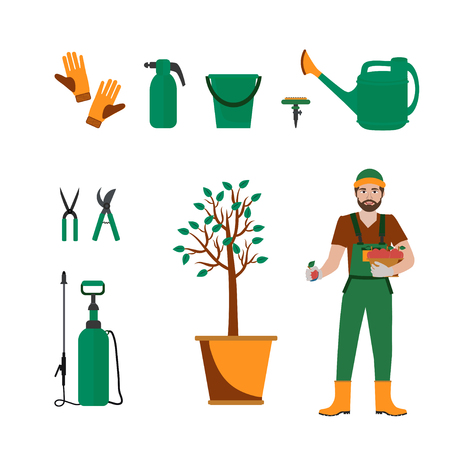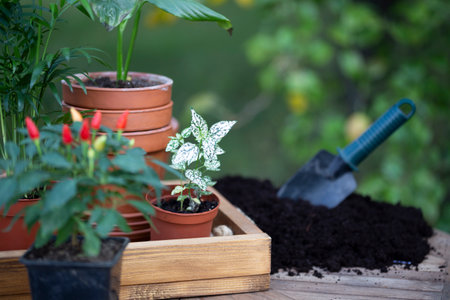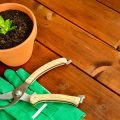1. Importance of Proper Tool Maintenance
Keeping your garden tools in good shape isn’t just about making them look nice—it’s about getting the job done faster, safer, and with less frustration. Whether youre a weekend gardener or a seasoned green thumb, maintaining your tools with the right essential oils and lubricants can make all the difference.
Why Maintenance Matters
Garden tools take a beating—from digging in tough soil to pruning woody stems. Over time, dirt, moisture, and rust can wear them down. Regular maintenance helps you avoid these problems before they start. Heres why its worth your time:
| Benefit | How It Helps |
|---|---|
| Increased Tool Longevity | Oiling metal parts prevents rust and corrosion, helping tools last for years. |
| Improved Performance | Lubricated moving parts work smoothly and efficiently, saving you effort. |
| Safer Usage | Clean, sharp tools reduce the chance of slipping or straining while working. |
Common Issues Without Maintenance
If you skip regular care, you might run into issues like:
- Rust buildup: Makes tools harder to use and shortens their life span.
- Dull blades: Require more force and can be dangerous when cutting.
- Stiff joints: Pruners and shears may not open or close properly without lubrication.
A Quick Tip
A little upkeep goes a long way. Wipe down tools after each use, apply a light coat of oil on metal parts, and store them in a dry place. These small steps prevent big problems later on.
Did You Know?
You can use natural essential oils like tea tree or clove oil as part of your tool care routine. They help fight rust and even have antibacterial properties—great for keeping your gardening gear clean and healthy.
By taking care of your garden tools regularly with the right oils and lubricants, youre not just preserving your investment—youre also making every gardening task easier and more enjoyable.
2. Types of Lubricants and Their Applications
Keeping your garden tools in top shape means more than just cleaning off the dirt after use. Using the right type of lubricant helps prevent rust, reduces wear and tear, and keeps moving parts operating smoothly. Heres a look at some of the most common lubricants used in garden tool maintenance and how to use them effectively.
Mineral Oil
Mineral oil is a gentle and versatile lubricant thats ideal for tools with wooden handles or cutting blades. Its food-safe, making it a great choice if youre working with tools used in vegetable gardens. It doesnt gum up over time and provides a light protective coating against moisture.
Best Uses:
- Pruning shears
- Harvesting knives
- Wooden handles (to prevent drying and cracking)
Silicone Spray
Silicone spray is a slick, water-repellent lubricant thats perfect for metal parts that move or slide. It dries quickly and doesn’t attract dirt, which makes it suitable for tools that are frequently exposed to soil and debris.
Best Uses:
- Hinges on pruning tools
- Loppers and hedge shears
- Telescoping handles
WD-40
WD-40 is a household name in lubrication, often used to displace moisture and free up stuck parts. While its not technically a long-term lubricant, it’s excellent for cleaning and loosening rusty tools before applying a more durable oil.
Best Uses:
- Removing rust from old tools
- Loosening stiff joints or bolts
- Initial treatment before applying mineral or silicone oil
Quick Comparison Table
| Lubricant Type | Main Benefit | Best For | Notes |
|---|---|---|---|
| Mineral Oil | Nourishes wood & protects metal blades | Cutting tools, wooden handles | Food-safe; needs reapplication regularly |
| Silicone Spray | Repels water & reduces friction | Moving joints, sliding parts | Dries clean; doesn’t attract dirt |
| WD-40 | Cleans & frees rusted parts | Rusty or stuck components | Not a permanent lubricant; follow up with another oil |
Selecting the right lubricant depends on the type of tool youre maintaining and its specific needs. By understanding these common options, you can keep your garden gear running smoothly all season long.

3. Popular Essential Oils for Natural Maintenance
When it comes to keeping your garden tools clean and in good shape, natural solutions like plant-based essential oils can be a smart and eco-friendly choice. These oils not only help remove dirt and grime but also offer antibacterial and antifungal properties that protect your tools from rust and decay. Below are some of the most popular essential oils used by gardeners across the U.S. for natural maintenance.
Tea Tree Oil
Tea tree oil is well known for its powerful antiseptic qualities. It can help kill bacteria and fungi that may build up on your gardening tools after working with soil or plants. Simply mix a few drops with water or white vinegar to create an all-natural cleaning solution.
Clove Oil
Clove oil is another great option for maintaining garden tools. Its strong antimicrobial properties make it ideal for preventing rust and mold. Plus, it has a pleasant spicy scent that adds freshness to your tool shed.
Eucalyptus Oil
Eucalyptus oil not only helps sanitize your tools but also acts as a natural insect repellent. This can be especially helpful if you store your tools in areas prone to bugs or pests. Use it as part of your regular cleaning routine to keep everything smelling clean and staying protected.
How to Use Essential Oils on Garden Tools
| Essential Oil | Main Benefit | How to Use |
|---|---|---|
| Tea Tree | Antibacterial & Antifungal | Mix with water or vinegar; spray and wipe tools |
| Clove | Rust Prevention & Antimicrobial | Add to carrier oil; apply thin layer on metal parts |
| Eucalyptus | Sanitizing & Insect Repellent | Combine with water; use as cleaning spray |
Tips for Best Results:
- Always clean off soil and debris before applying oils.
- Store tools in a dry place after treatment.
- Reapply essential oils every few weeks, especially during high-use seasons.
Using essential oils is a simple yet effective way to care for your garden equipment without relying on harsh chemicals. Theyre safe, natural, and align well with sustainable gardening practices.
4. How to Clean and Lubricate Garden Tools Properly
Keeping your garden tools clean and well-oiled not only extends their life but also makes your gardening tasks easier and safer. Whether youre working with pruners, shears, or trowels, giving them proper care after each use can prevent rust, keep blades sharp, and ensure smooth operation. Follow this step-by-step guide using essential oils and lubricants commonly available in the U.S.
Step-by-Step Guide for Cleaning and Oiling Garden Tools
Step 1: Gather Your Supplies
Before you start, make sure you have everything you need:
| Item | Purpose |
|---|---|
| Warm soapy water | Cleans dirt and debris |
| Wire brush or steel wool | Scrubs off rust and grime |
| Clean cloth or rag | Wipes tools dry and applies oil |
| Essential oils (e.g., tea tree or clove oil) | Natural disinfectant and rust prevention |
| Lubricant oil (e.g., 3-IN-ONE Multi-Purpose Oil) | Keeps moving parts functioning smoothly |
| WD-40 or similar rust inhibitor | Protects against moisture buildup |
Step 2: Scrub Off Dirt and Sap
Start by rinsing your tools in warm, soapy water to loosen soil and plant residue. Use a wire brush or steel wool to scrub off any stubborn grime or rust. For sticky sap, rubbing alcohol or vinegar works well to break it down.
Step 3: Dry Thoroughly
Use a clean towel to completely dry your tools. Leaving moisture on the metal can lead to rust, especially in humid climates.
Step 4: Disinfect Using Essential Oils
Add a few drops of tea tree oil or clove oil to a cloth and wipe down the tool surfaces. These essential oils are known for their antibacterial properties and help prevent the spread of plant diseases.
Step 5: Lubricate Moving Parts
If your tool has any moving parts like hinges (as with pruners or shears), apply a small amount of multi-purpose lubricant such as 3-IN-ONE Oil. Work the oil into the joint by opening and closing the tool several times.
Step 6: Apply Rust Protection
A light spray of WD-40 or a coating of linseed oil can help protect metal surfaces from moisture that causes rust. Wipe off any excess with a clean cloth.
Step 7: Store Properly
Store your clean, oiled tools in a dry place. Hanging them up or keeping them in a toolbox off the ground helps avoid exposure to dampness. You can also wrap them in a lightly oiled cloth for added protection.
Quick Tool Care Tips Table
| Tool Type | Main Concern | Recommended Oil/Lubricant |
|---|---|---|
| Pruners & Shears | Sap buildup, dull blades | Tea tree oil + 3-IN-ONE Oil |
| Trowels & Hand Forks | Dirt corrosion, rust spots | Clove oil + WD-40 spray |
| Loppers & Hedge Trimmers | Sticky joints, blade wear | Lubricating oil + Linseed oil wipe-down |
A little routine maintenance using essential oils and lubricants goes a long way in keeping your garden tools in top shape all season long.
5. Seasonal Maintenance Tips for American Gardeners
Keeping your garden tools in top shape year-round takes a bit of planning—especially when you factor in the different climates across the U.S. Whether youre battling snow in the Northeast or prepping for spring planting in California, using essential oils and lubricants at the right time of year can make a big difference in tool longevity and performance.
Regional Climate Considerations
The U.S. spans multiple climate zones, so its important to tailor your maintenance schedule based on where you live. Here’s a quick guide to help you stay on track:
| Region | Seasonal Focus | Maintenance Tips | Recommended Oils/Lubricants |
|---|---|---|---|
| Northeast & Midwest (Cold Winters) | Fall/Winter Prep | Clean off soil and sap; sharpen blades; apply protective oil before storage | Mineral oil, linseed oil for wood handles, silicone spray for metal parts |
| Southeast (Humid & Warm) | Spring/Summer Use | Check for rust monthly; wipe tools with oil after use to prevent corrosion | Lemon eucalyptus oil as natural rust inhibitor; WD-40 for moving joints |
| Southwest (Hot & Dry) | Year-Round Maintenance | Keep wooden handles from drying out with regular oiling; store tools out of direct sun | Tung oil or boiled linseed oil for wood; light machine oil for joints |
| Pacific Northwest (Wet & Mild) | Rainy Season Prep | Dry tools thoroughly after use; apply water-repellent oils regularly | Camellia oil for anti-rust; beeswax-oil blends for moisture resistance |
| California (Varied Climates) | Spring Planting / Fall Storage | Tune up tools before spring; deep clean and lubricate before winter storage if needed | Coconut oil as eco-friendly option; 3-in-1 multipurpose oil for all-around use |
Monthly Quick Check Routine
No matter where you live, setting a monthly reminder to do a quick check on your tools will save you time and money. Wipe down blades, inspect wooden handles, and reapply lubricants or oils as needed. This habit ensures your tools are always ready for action—whether it’s planting season or time to put them away.
Tip:
If youre not sure what kind of oil to use, start with food-safe mineral oil—it’s widely available, inexpensive, and works well on both metal and wood.
Bonus Tip for Winter Storage:
Dip metal tool heads in sand mixed with motor oil or linseed oil before storing. This old-school trick keeps rust at bay and makes your first spring gardening day much easier.
6. Safety and Storage Considerations
After applying essential oils or lubricants to your garden tools, proper storage is key to keeping them in great shape and ensuring your safety. A well-organized shed or garage not only extends the life of your tools but also helps reduce fire risks and exposure to potentially harmful chemicals.
Best Practices for Safe Tool Storage After Oiling
Once youve cleaned and oiled your tools, store them in a dry place with good air circulation. This prevents rust and keeps wooden handles from rotting. Hanging tools on wall hooks or pegboards is a great way to keep them off damp surfaces. Use containers or bins for smaller items like pruners or trowels.
Tool Storage Tips:
| Tool Type | Storage Method | Why It Works |
|---|---|---|
| Hand Tools (e.g., pruners, trowels) | Stored in labeled bins or drawers | Keeps them organized and easy to find |
| Long-Handled Tools (e.g., rakes, shovels) | Hang vertically on wall-mounted hooks | Prevents warping and saves floor space |
| Oiled Tools | Wrapped in cloth or stored in tool rolls | Protects from dust and prevents oil transfer |
Minimizing Fire Hazards in Garden Sheds
Many essential oils and lubricants are flammable, so its important to store them safely. Keep all oil-soaked rags in a sealed metal container to prevent spontaneous combustion. Never leave these rags piled up, especially during hot summer months.
Fire Safety Tips:
- Store oils and lubricants: in original containers with tight-fitting lids, away from direct sunlight and heat sources.
- Use metal safety cans: for oily rags and dispose of them regularly.
- Avoid open flames: such as grills or heaters near your garden shed workspace.
- Add a smoke detector: inside your shed for early fire warning.
Avoiding Chemical Exposure
If youre using essential oils like tea tree or eucalyptus for their natural antifungal properties, remember that even natural oils can cause skin irritation or allergic reactions. Always wear gloves when applying them, and make sure your shed is well ventilated.
Chemical Safety Checklist:
- Label all containers: even homemade blends should be clearly marked.
- Wear protective gear: such as gloves and eye protection during application.
- Avoid inhaling fumes: by opening windows or installing vents if working indoors.
- Keep products out of reach of children and pets:
Taking these simple steps will help you maintain a safer, more efficient gardening workspace while protecting both your tools and yourself.


